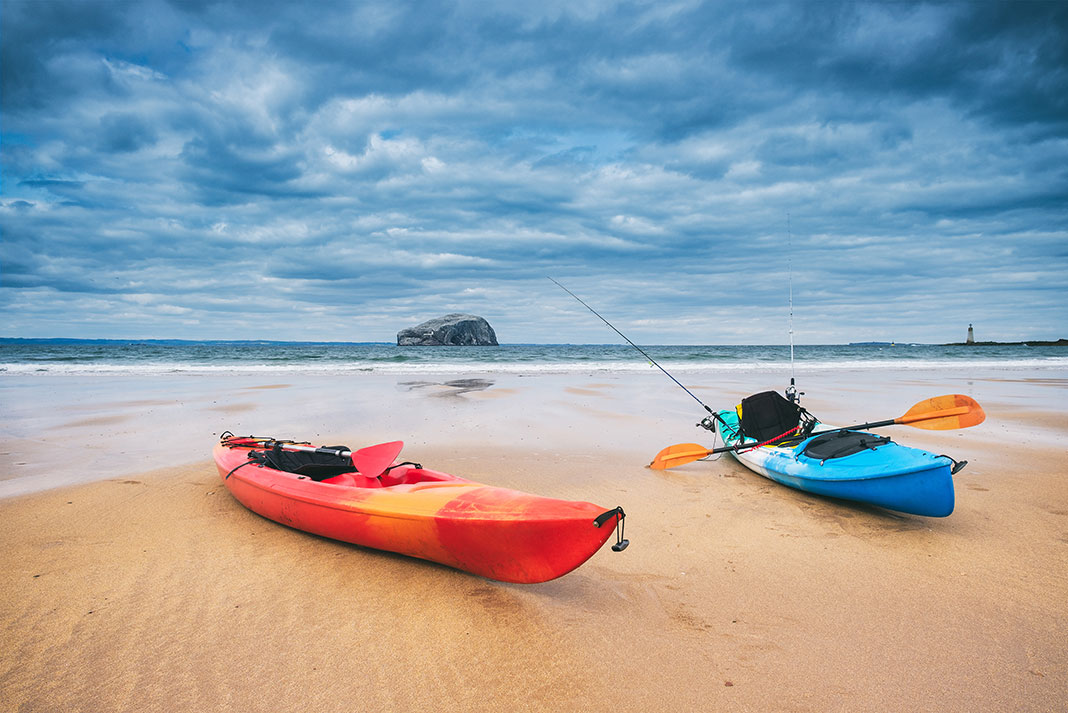The biggest mistake many beginning kayakers make is buying a beginner kayak. Jumping into the cheapest and simplest boat just to see if you’ll like it means you probably won’t have much fun. Instead, the suggestion from kayaking experts is to spend a little more time and money up front. Get a better boat and you’re likely to have a better experience, too.
No one knows new kayak anglers like the folks working at a local paddle shop, so we reached out to three of our friends who walk the showroom floor. They encourage first timers to research, answer basic questions and don’t believe the hype. To get newbies started and keep them hooked for years, our experts point to a new class of entry-level kayaks with efficient designs and smart features at a great value.
5 Questions to Ask Before Buying Your First Kayak
1How Does the Kayak Fit?
The first question our pros ask new customers is a little personal. “We start with height and weight,” says Brian Kidd from Delaware Paddlesports.
Turns out one size does not fit all.

At Fuzzy Guppies in upstate New York, Justin Hausner’s first question for new paddlers is: “Does this kayak fit your body style?” Across the country at Austin Canoe and Kayak, Carlos Andreu complains, “One of the biggest mistakes is a customer returning a kayak because it doesn’t fit.”
A larger angler may feel more comfortable in a wider kayak while a shorter angler looks for a narrow boat. Smaller, lighter paddlers may prefer to paddle while larger, heavier anglers go farther with less effort by using pedals or a motor.
2Is the Seat Comfortable?
Fit comes down to more than length and width of the kayak. Our experts say the kayak’s seat is the first thing to test. Justin Hausner’s first requirement is a comfortable seat. “Make sure you are comfortable and able to sit for a long period of time,” he stresses. “When test driving the kayak stand up and sit down to make sure it fits you.”
Brian Kidd agrees, not only should the seat be padded, fast drying and adjustable, but it must provide a solid platform for paddling and pedaling. “New anglers don’t realize how many hours they will spend sitting in the seat,” he points out. Matching the angler’s body size to the seat size ensures the kayak fits like a glove.

3How Will I Use the Kayak?
After the experts determine the size of the best kayak, they look at how the customer will use the boat.
Brian Kidd says, “Once I know the angler’s height and weight, I ask what type of water they fish.” If the angler focuses on rivers, Kidd suggests a paddle kayak. For backwaters, shallows and ponds, he might push for a smaller boat. Big water calls for an appropriately seaworthy craft. Paddles, pedals and motors have advantages and disadvantages.
At ACK, Carlos Andreu says he sees boats come back, “because they didn’t perform in the intended application or conditions.” With so many models available at an entry level price, the experts say there is a kayak for every type of fishing in any angler’s budget.
4What Features Do I Need?
The last question on Carlos Andreu’s list is: “Desired features on the kayak?” One way the latest beginner boats cut cost is with fewer rod holders, gear tracks and hatches. For beginners, accessories are less important. Andreu points out rod holders and electronics can be added later.
Before making a recommendation, Hausner tries to predict if a customer will quickly grow out of a kayak. The ability to customize creates a boat that will meet the angler’s changing needs. A kayak with gear tracks, mounting pads and transducer rigging will adapt with its owner.
“How will the kayak be transported” is number three on Carlos Andreu’s list for first timers. A big, heavy boat may require a trailer and heavy-duty cart. Andreu asks, do you have space to store the kayak out of direct sunlight? He reminds owners a kayak should be stored on its side or propped on the stern.
5Can I Take a Test Drive?
When we asked about the biggest mistake newbies make, our experts shake their head in unison. Justin Hausner starts, “Not demoing the boat or doing research.” Brian Kidd agrees, “Buying a kayak on a whim.” At the same time, Carlos Andreu echoes, “Setting their mind on a kayak that looks good on paper or becoming an expert from reading message boards.”

All three agree, buying a kayak based on another angler’s opinions will not result in the best fit. First and foremost, these pros urge freshmen fishermen to test drive a kayak before they buy it.
Best Beginner Kayak Traits
We asked our experts to describe the best beginner kayak. Here is where they landed.
Price: Around $1,000 for a paddle kayak and $2,000 for a pedal boat.
Stability: Inspires confidence, but slows performance.
Comfortable seat: The Achilles heel of any kayak and one place cheap kayaks cut corners.
Easy to maneuver: Operating the kayak shouldn’t be difficult.
Basic Features: A couple of rod holders.
Twelve feet long: The sweet spot between efficiency and maneuverability.
Overall fit: Length, width, seat and power dialed into the angler’s size and ability.

From first boat to forever boat. | Feature photo: Roberto Westbrook











I’ve been absent for some time, but now I remember why I used to love this web site. Thank you, I will try and check back more often. How frequently you update your website?